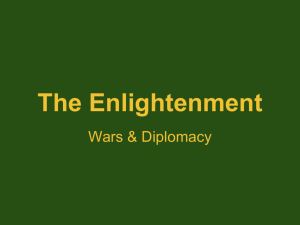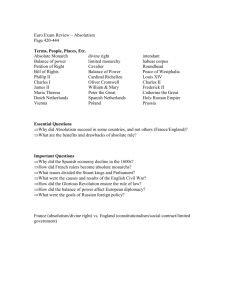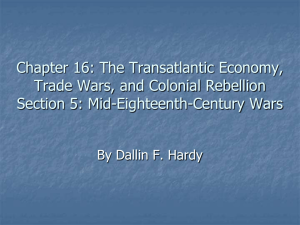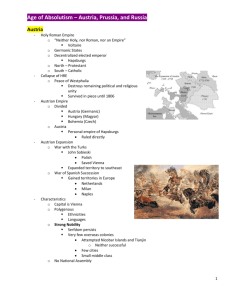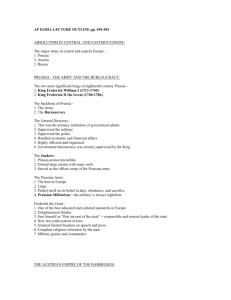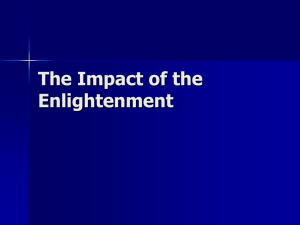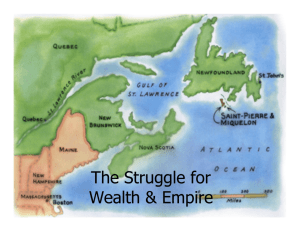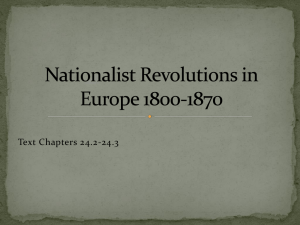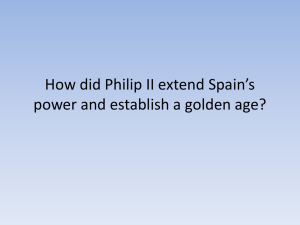Central European Absolutism 2
advertisement
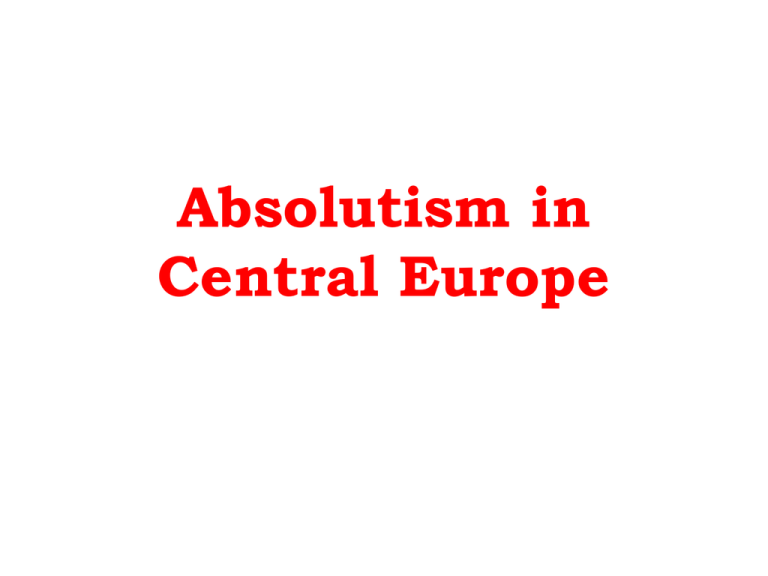
Absolutism in Central Europe Absolutism in 17th Century Central Europe • Economic and social conditions made Absolutism different in Central Europe: – Powerful nobility and much poorer peasantry – Less industrial and more rural – Fewer towns – Monarchs had a more difficult time diminishing power of nobility in the countryside. • As a trade-off, the monarch gave the aristocrats even greater power over their own peasants in return for their support for his centralized government. Hapsburgs and the Holy Roman Empire The Hapsburg Empire • Religious and ethnic divisions. Ethnic hostility. • Habsburgs needed the aristocracy to secure their rule. • Economically backward, compared to France, England. Fewer towns, lack of industry. • Aristocrats had almost complete control over their large peasant populations. Serfdom. – Serfdom allowed by Hapsburgs to gain support of aristocracy How the Hapsburg’s Gained Power • Began as minor Swiss nobility in the middle ages • By 1558, the Hapsburg empire had become one on “which the sun never set.” • Not just Holy Roman Emperors, but also: – Dukes of wealthy Burgundy and the “Low-Counties” – Kings of Bohemia and Hungary – Kings of Spain (which included more than half of the Americas and the Philippines) • How did that happen? Warfare? Wealth? Diplomatic excellence? Yes. • But mostly, they gained power, wealth, and status through smart marriages. • A Latin verse from the 16th century states: “Let others wage war, you - happy Austria - marry!" Good Marriages = Power • Marriages to princesses of Burgundy, Spain, Bohemia, and Hungary Mary of Burgundy Joanna of Castile Leopold I • 1640-1705 • Younger son, never intended to rule • Well educated, but meant for the monastery • Very shy Leopold I • Peer of Louis XIV but much different personality – Preferred to live a secluded life – Enforced strict royal court protocol from the Spanish court – Dressed in somber black – Inquisitive: loved books and science experiments Leopold I • Holy Roman Emperor, also king of Hungary, Bohemia, Croatia • Ruled 47 years Leopold I • Problems with France – Spanish Succession – Grand Alliance: Austria and England vs. France over the Netherlands • Problems with the Turks – Turks keep challenging Austrian Empire – 1663-1683: Turkish army comes close to conquering Vienna – 1699: Sultan signs peace treaty with Leopold Schonbrunn Palace Schönbrunn Palace Schönbrunn Palace Hohenzollerens of Brandenburg-Prussia Prussia in early 18th century Prussia is divided by German states. Early Prussian History • Brandenburg-Prussia was a scattered collection of domains centered around Berlin. • During the Thirty Years' War, Prussian lands were repeatedly marched across by various armies • Frederick William (1640-1688) begins creating the Prussian Army Junker • Means “young lord” in German • Usually a lesser noble in the Middle Ages • Took up careers as soldiers and mercenaries. • Became the aristocracy of Prussia • They dominated all the higher civil offices and officer corps of the army and navy • Strong supporters of monarchy and tradition King Frederick I of Prussia • Reigned 1701-1713 • The “soldier king” • Developed the Prussian army into one of the most powerful in Europe • In view of the size of the army in relation to the total population Voltaire said later: "Where some states possess an army, the Prussian Army possesses a state!" Frederick II – “The Great” • Reigned 1740-1786 • Invaded the Austrian province of Silesia • Made Prussia a great power • Laid the foundation for the eventual unification of German states into Germany Frederick II • Admired the French Enlightenment and philosopher Voltaire • Did not believe in the Divine Right of Kings • Practiced “Enlightened Absolutism” Charles VI • Reigned 1711-1740 • Feared his daughter would not keep the empire intact • Pragmatic Sanction of Prague • While alive, persuaded other European nations to agree to it. Hoped to prevent war. • Reality: at his death, Europe sank into another era of warfare – Prussia immediately seized Silesia, an Austrian province – Austria declared war on Prussia • Empress Maria Theresa • Reigned 17401780 • Strengthened Austria militarily, economically, intellectually Maria Theresa and Her Family • 16 children • One of her youngest daughters was Marie Antoinette, queen of France War of the Austrian Succession • Began in 1740 • The accession of Maria Theresa to the Habsburg Empire after the death of her father, the Holy Roman Emperor Charles VI, created a crisis. • The war involved all of Europe – France and England fought for power in Europe and to become strongest colonial power – Conflict spread to America, where it was known as King George's War • France, Prussia, Spain vs. Austria and Britain • Potential upset of the “Balance of Power” – Britain feared a too-powerful France War of Austrian Succession • Major Battles – 1st Silesian War: 1741, Austrian and French defeat • Encouraged France, Spain, and Prussia to tear apart and take Austrian lands – 2nd Silesian War: 1742, Austria and Prussia make peace, but war continues in North America and Low Countries – The war shifts after 1742 to more direct conflict between France and England • Battle of Dettingen (1943): French defeat • Battle of Fontenoy (1745): French victory The War Ends? • The End: Treaty of Aix-le-Chapelle (1748) – Prussia gets to keep Silesia – Prussia becomes a major European power • The End is really the Beginning – The Seven Years War began in 1755 – Result: France loses most presence in N. America, England becomes most dominant colonial power Poland • 15th -- 16th Century: “Golden Age” of stability and advancement • Downfall: – Partitions of Poland: 1772-1795 • Divided amongst Austria, Prussia, and Russia • 1795: End of Poland as a nation until the Napoleonic Era

